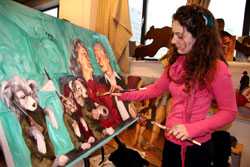Art students occupy the VA Building fourth floor
Not for protest, but for large scale production

Studio Arts student Kate Puxley takes advantage of unused VA Building space to work on one of her projects.
Photo by robert winters
When the Faculty of Fine Arts moved several departments to the new EV Building, the fourth floor of the Visual Arts Building was left empty – but not for long
The empty spaces were turned over temporarily to Painting and Drawing students, who staked out their claims in a land-rush flurry, then started working harder than ever. Their veritable renaissance of vibrant art-making that has caught even seasoned professors by surprise.
François Morelli, coordinator of the Painting and Drawing program, appreciates the explosion of art-making since undergraduate students suddenly had extra space.
The recent show of “stunning” undergraduate work at the high-profile Art Mûr gallery provided a powerful showcase for this new vibrancy, Morelli said in an interview. Work in the show was selected by a jury of faculty members.
Kate Puxley, a final-year Studio Arts student, staked out a prime corner space on the fourth floor, where she has been working constantly, spurred on by the excitement of having her own space to work in. It’s a luxury she never had before, when all the painting and drawing students were crammed into a few small studios on the third floor of the VA building.
When the students requested use of the space last fall, Dean of Fine Arts Catherine Wild showed foresight by allowing it, Morelli said.
“For me, this only reflects the age-old relationship visual artists have had as real-estate developers, and how painting and drawing as an activity blossoms with space – not temporary space, but permanent space which a community can claim and inhabit.”
Marisa Hoicka, a first-year Studio Arts student, said she’sable to work on larger pieces than would have been possible in the regular painting studios. It has also allowed a fertile exchange of ideas and techniques in a non-classroom setting and franker feedback than in class.
Robin Schurman, a final-year Studio Arts student, said she likes not having to set up materials each time she wants to work. The students have created an inviting atmosphere that makes everybody want to be in their studio spaces as much as possible. “There are always people here,” she said.
Now the students are working on organizing a show of their work on the fourth floor. When classes end, they hope to invite the public to see the strong work they’ve been producing in their temporary digs.
“Painting and drawing have never died; they have more often been physically contained,” Morelli said.
Previously, painting and drawing students were limited to about 1.3 square metres of space each.
Morelli said the fourth-floor experiment provides “further proof that creativity is not necessarily related to equipment, technology and human resources.”
